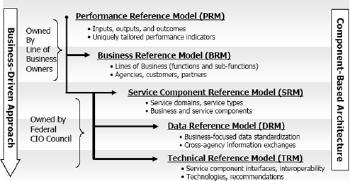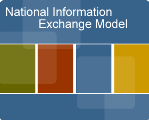I had the extremely good fortune to stumble upon a document on XML.gov that describes the cohesion between the varying areas of state government work that I am involved in. The document, a report on the E-Government Act of 2002, Section 212, was a revelation of previously unknown relationships between many areas of my work. Despite the fact that the document was written for the federal government, it appears to be very applicable to state government as well.

The report highlights enterprise architectural elements as well as pilot implementations underway to support presidential e-government initiatives. I’ve touched on a couple of these examples below.
Federal Enterprise Architecture (FEA) – The FEA consists of five reference models (business, performance, service, technical, and data) and a seriesof policies to help link IT investments with the reference models to help identify commonalities and IT spending priorities across the government’s agencies.

The FEA obviously does not apply to state government out-of-the-box. However, the extensible structure of each of the FEA reference models facilitates customization. The Commonwealth of Virginia provides an exceptional example of how this can be implemented in practice. Virginia has used the FEA as their model and, from the top down, has begun creating the business reference model in a manner consistent with the operation of state government. I have not seen any other work of this quality and breadth made publicly available by other states. I’ve included a local reference to their enterprise business model below.
Grants Management Pilot Project – I’ve been spending a bit of time familiarizing myself with the grants management domain over the past several months and posted on this topic more than once. With the passing of the Federal Funding Accountability and Transparency Act of 2006, focus on this area is likely to get even more intense at the federal and state levels in the next couple of years. Special thanks go out to Dave Cassidy of TCG for pointing me to the right section of Grants.gov with some meaty design and implementation details concerning granting system information exchanges.
Case Management Pilot Project – Case management has a place near and dear to my heart. My state government pattlets all deal with case management and it’s an area where I have some experience and even more opinions. It is encouraging to see the federal government aspiring to move towards data unity in this area. I have my doubts however. Case management, with its diversity of data elements and business practices, seems to have antibodies that preclude any form of true standardization. Normalization seems more likely to me here.

The National Information Exchange Model (NIEM) was mentioned as a unifying enabler. I am encouraged to see government pursuing data standardization so rigorously with NIEM. They seem to have made great progress in areas related to homeland security and are now eyeing other areas. I long for the day when NIEM becomes a first class citizen of the integration standards world and garners widespread vendor support like its industry brethren, SWIFT, HL7, and RosettaNet.